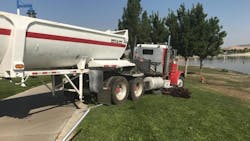Did you know we’re on the eve on one of the deadliest days in the trucking industry? That’s right: October 11.
Apparently, according to data tallied by Zonar Systems over the last three years, October 11 and June 7 are the two deadliest days for truck drivers – days on which 397 truck-involved collisions happen, with the highest odds of a truck being involved in a fatal accident occurring between 7 pm and 10 pm, with 31% of total fatalities taking place during that time window.
Zonar said that’s “unusual” as crash statistics for the rest of the year indicate that an average of only 1.3% of fatal truck-involved crashes occur at dusk.
Here’s another scary factoid Zonar dug up from its data: the most dangerous stretch of road to drive on October 11 is Route 6 between the number zero and three mile markers near the Nebraska/Colorado state line.
That’s because 63 total fatalities involving a truck on that date for the past three years occurred on that three mile section of road – accounting for 15.9% of the 397 fatalities Zonar tallied for October 11 and June 7 combined.
Yet isn’t this the very purpose of trucking’s data-driven efforts these days? To dig up information that will hopefully help fleets and drivers alike know where the “danger spots” are?
Indeed, according to data released by the National Highway Traffic Safety Administration (NHTSA), 4,317 fatalities occurring last year in crashes involving large trucks, which is 5.4% higher when compared to 2015 and is also the highest level of large truck crash deaths since 2007.
For some further insight into what data capture and analysis can reveal about truck driver behavior behind the wheel and how it impacts safety, I traded emails with Slaven Sljivar and David Forney, respectively vice president of analytics and a data scientist with SmartDrive. Here’s what they told me:
What are the biggest risk factors for a truck crash based on the data SmartDrive has analyzed? Please rank the factors according to the highest risk.
We’ve identified 27 different observations of risky driving maneuvers or actions that occur at least 20% more frequently for collision drivers than non-collision drivers. Comprehensive data has shown that inattention (use of a mobile device, eating or drinking, reading paperwork, etc.), violation of driving rules (traffic light and stop sign violations), and poor driving skills (e.g. late braking) are highly correlated with risk.
What are the calculations needed to figure out how risky a fleet’s drivers are? How does a fleet rank its drivers?
To measure risk, we calculate the rate at which drivers engage in risky maneuvers or habits that are correlated to collisions—data that is best assessed via video events. Then, by properly weighing each risky driving observation based on collision correlation, we can estimate relative risk among drivers. Fleets can rank drivers at the company level or drill down into driver ranks at various site levels.
Risk measurement begins with our SmartRecorder telematics device, which is designed to capture 20 to 30 second video events only when an exception situation arises and is detected by on-board triggering algorithms. Then our video analysts review all of the incoming video and determine whether one or more risk-relevant observations apply. Each driver is given a score based on his or her performance, enabling the fleet to rank drivers according to risk.
However, those scores are not stagnant. Low risk drivers can become high risk drivers and vice versa, and because of turnover, new drivers with higher risk factor may join the fleet while safer drivers may leave. Therefore, it is critical to accurately measure all drivers throughout the year in order to have a clear picture of fleet risk and prevent collisions.
Many drivers don’t like in-cab cameras; they view them as an invasion of privacy. How do you combat that?
First, it is important for drivers to understand how exactly their in-cab video system works. Many are under the impression that the in-cab camera is recording at all times or provides fleet managers with a continuous live feed. However, our system only records when triggered by a potentially risky driving maneuver (such as a hard brake, swerve, close following, lane departure, U-turn, etc.), and provides a brief clip for the sole purpose of determining the cause of the maneuver and verifying whether risk exists.
Additionally, video evidence is commonly used to exonerate drivers when they are not at fault, helping keep their records clean, reducing potential downtime and saving their company money in claims litigation.
It really all comes down to how well fleet managers communicate the purpose and design of video-based safety systems to drivers.
What do fleets and drivers stand to gain by using video to analyze risk factors in this manner?
By measuring risk throughout the year, fleets can quickly identify high-risk drivers, coach them on specific skills needed to improve and monitor their progress. This helps fleets significantly reduce the frequency of collisions. Return on investment (ROI) analyses that balance the benefits and costs of the system routinely show payback in six to 12 months.
In addition, video evidence can be used to exonerate drivers when they are not at fault, resulting in cost savings associated with litigation, claims and liability.
Furthermore, since drivers can be coached on specific practices such as speeding or hard-braking that waste fuel, many fleets notice cost savings associated with better fuel efficiency.
Just goes to show that data can paint a much more detailed picture regarding trucking operations and safety than we believe is possible.
